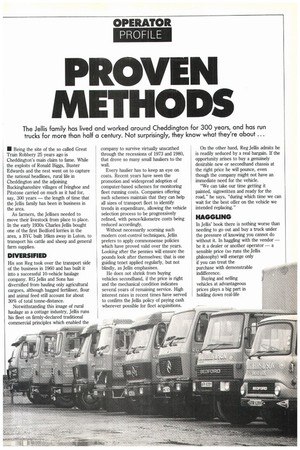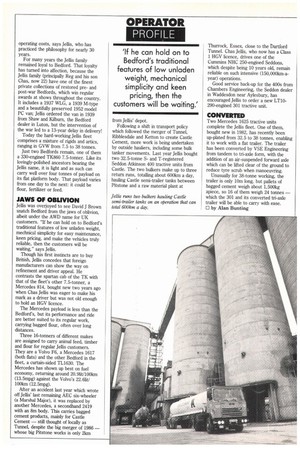PROVEN METHODS
Page 53

Page 54

If you've noticed an error in this article please click here to report it so we can fix it.
The Jellis family has lived and worked around Cheddington for 300 years, and has run trucks for more than half a century. Not surprisingly, they know what they're about ...
• Being the site of the so called Great Train Robbery 25 years ago is Cheddington's main claim to fame. While the exploits of Ronald Biggs, Buster Edwards and the rest went on to capture the national headlines, rural life in Cheddington and the adjoining Buckinghamshire villages of Ivinghoe and Pitstone carried on much as it had for, say, 300 years — the length of time that the Jellis family has been in business in the area.
As farmers, the Jellises needed to move their livestock from place to place. In the early 1930s Charles Jellis bought one of the first Bedford lorries in the area, a BYC built 16km away in Luton, to transport his cattle and sheep and general farm supplies.
DIVERSIFIED
His son Reg took over the transport side of the business in 1960 and has built it into a successful 10-vehicle haulage company. RG Jellis and Sons has diversified from hauling only agricultural cargoes, although bagged fertiliser, flour and animal feed still account for about 30% of total tonne-distance.
Notwithstanding this image of rural haulage as a cottage industry, Jellis runs his fleet on firmly-declared traditional commercial principles which enabled the company to survive virtually unscathed through the recessions of 1973 and 1980, that drove so many small hauliers to the wall.
Every haulier has to keep an eye on costs. Recent years have seen the promotion and widespread adoption of computer-based schemes for monitoring fleet running costs. Companies offering such schemes maintain that they can help all sizes of transport fleet to identify trends in expenditure, allowing the vehicle selection process to be progressively refined, with pence/kilometre costs being reduced accordingly.
Without necessarily scorning such modern cost-control techniques, Jellis prefers to apply commonsense policies which have proved valid over the years. Looking after the pennies will ensure the pounds look after themselves; that is one guiding tenet applied regularly, but not blindly, as Jellis emphasises.
He does not shrink from buying vehicles secondhand, if the price is right and the mechanical condition indicates several years of remaining service. High interest rates in recent times have served to confirm the Jellis policy of paying cash wherever possible for fleet acquisitions. On the other hand, Reg Jellis admits he is readily seduced by a real bargain. If the opportunity arises to buy a genuinely desirable new or secondhand chassis at the right price he will pounce, even though the company might not have an immediate need for the vehicle.
"We can take our time getting it painted, signwritten and ready for the road," he says, "during which time we can wait for the best offer on the vehicle we intended replacing."
HAGGLING
In Jellis' book there is nothing worse than needing to go out and buy a truck under the pressure of knowing you cannot do without it. In haggling with the vendor — be it a dealer or another operator — a sensible price (so runs the Jellis philosophy) will emerge only if you can treat the purchase with demonstrable indifference.
Buying and selling vehides at advantageous prices plays a big part in holding down real-life operating costs, says Jellis, who has practiced the philosophy for nearly 30 years.
For many years the Jellis family remained loyal to Bedford. That loyalty has turned into affection, because the Jellis family (principally Reg and his son Chas, now 22) have one of the finest private collections of restored preand post-war Bedfords, which win regular awards at shows throughout the country. It includes a 1937 WLG, a 1939 M-type and a beautifully preserved 1952 model PC van; Jellis ordered the van in 1939 from Shaw and Kilburn, the Bedford dealer in Luton, but the intervention of the war led to a 13-year delay in delivery!
Today the hard-working Jellis fleet 'comprises a mixture of rigids and artics, ranging in GVW from 7.5 to 38 tonnes.
Just two Bedfords remain, one of them a 330-engined TK860 7.5-tonner. Like its lovingly-polished ancestors bearing the Jellis name, it is light and as such can carry well over four tonnes of payload on its flat platform body. That payload varies from one day to the next: it could be flour, fertilizer or feed.
JAWS OF OBLIVION
Jellis was overjoyed to see David J Brown snatch Bedford from the jaws of oblivion, albeit under the AWD name for UK customers. "If he can hold on to Bedford's traditional features of low unladen weight, mechnical simplicity for easy maintenance, keen pricing, and make the vehicles truly reliable, then the customers will be waiting," says Jellis.
Though his first instincts are to buy British, Jellis concedes that foreign manufacturers can show the way on refinement and driver appeal. He contrasts the spartan cab of the TK with that of the fleet's other 7.5-tonner, a Mercedes 814, bought new two years ago when Chas Jells was eager to make his mark as a driver but was not old enough to hold an HGV licence.
The Mercedes payload is less than the Bedford's, but its performance and ride are better suited to its regular work, carrying bagged flour, often over long distances.
Three 16-tonners of different makes are assigned to carry animal feed, timber and flour for regular Jellis customers. They are a Volvo F6, a Mercedes 1617 (both flats) and the other Bedford in the fleet, a curtain-sided TL1630. The Mercedes has shown up best on fuel economy, returning around 20.91it/1001cm (13.5mpg) against the Volvo's 22.6Iit/ 100km (12.5mpg).
After an accident last year which wrote off Jellis' last remaining AEC six-wheeler (a Marshal Major), it was replaced by another Mercedes, a secondhand 2419 with an 8m body. This carries bagged cement products, mainly for Castle Cement — still thought of locally as Tunnel, despite the big merger of 1986 — whose big Pitstone works is only 21cm from Jellis' depot.
Following a shift in transport policy which followed the merger of Tunnel, Ribblesdale and Ketton to create Castle Cement, more work is being undertaken by outside hauliers, including some bulk tanker movements. Last year Jellis bought two 32.5-tonne Sand T-registered Seddon Atkinson 400 tractive units from Castle. The two bulkers make up to three return runs, totalling about 600krn a day, hauling Castle semi-trailer tanks between Pitstone and a raw material plant at Jellis runs two blithers hauling Castle semi-trailer tanks on an operation that can total 600km a day. Thurrock, Essex, close to the Dartford Tunnel. Chas Jellis, who now has a Class 1 HGV licence, drives one of the Cummins NHC 250-engined Seddons, which despite being 10 years old, remain reliable on such intensive (150,0001:n1-ayear) operations.
Good service back-up for the 400s from Chambers Engineering, the Seddon dealer in Waddesdon near Aylesbury, has encouraged Jellis to order a new LT10290-engined 301 tractive unit.
CONVERTED
Two Mercedes 1625 tractive units complete the Jellis fleet. One of them, bought new in 1982, has recently been up-plated from 32.5 to 38 tonnes, enabling it to work with a flat trailer. The trailer has been converted by VSE Engineering from tandem to tri-axle form, with the addition of an air-suspended forward axle which can be lifted clear of the ground to reduce tyre scrub when manoeuvring.
Unusually for 38-tonne working, the trailer is only 10m long, but pallets of bagged cement weigh about 1,500kg apiece, so 16 of them weigh 24 tonnes — which the 301 and its converted tri-axle trailer will be able to carry with ease. El by Alan Bunting




























































































